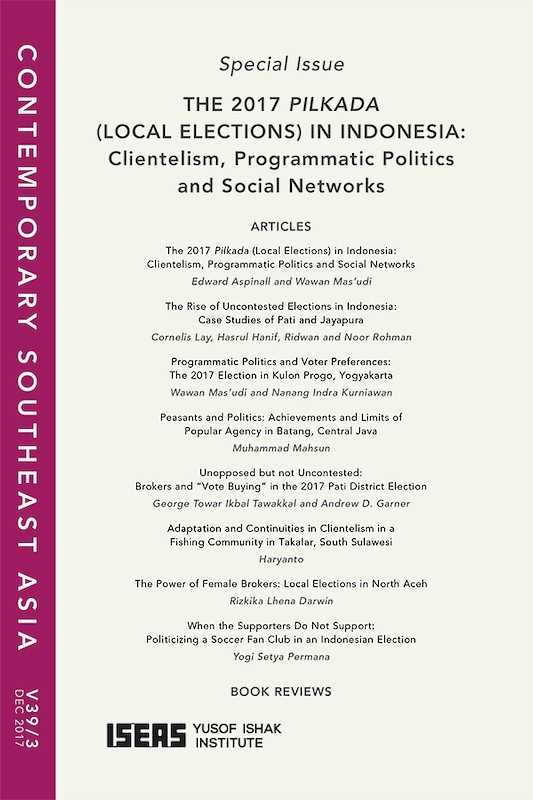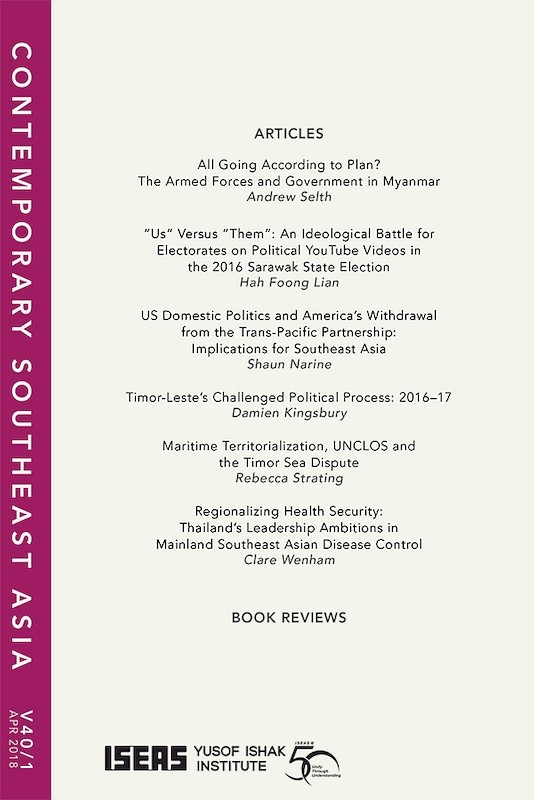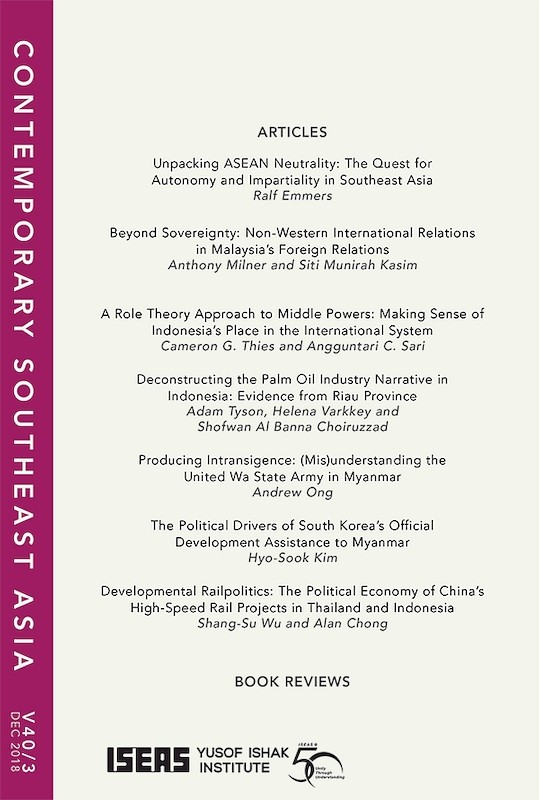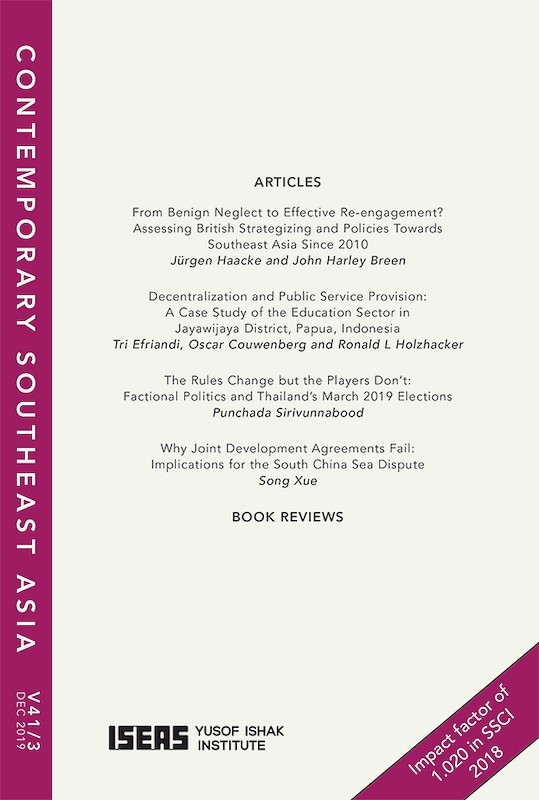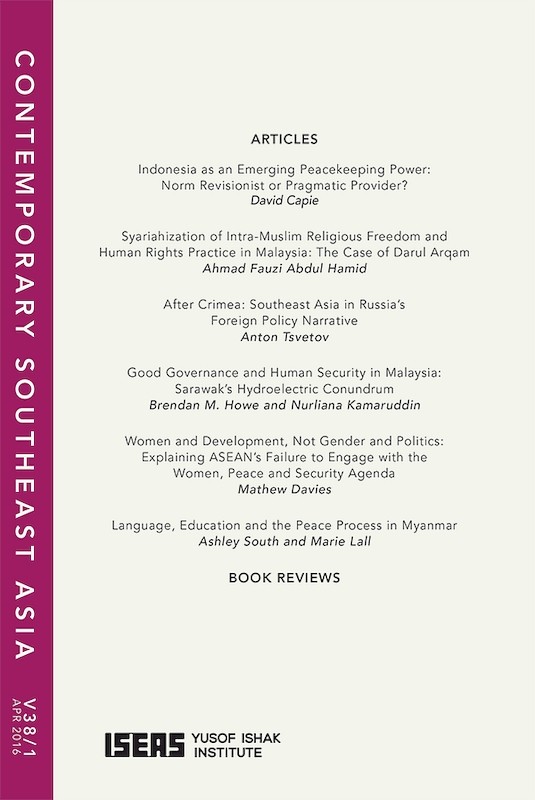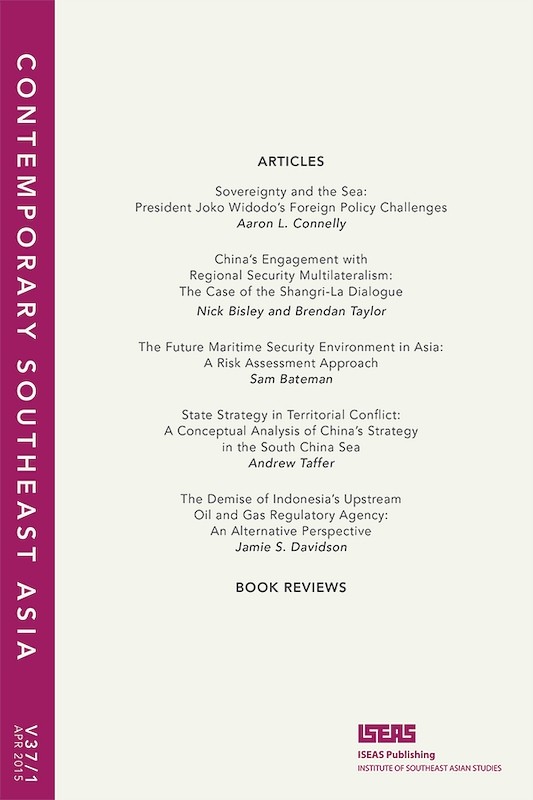Contemporary Southeast Asia Vol. 39/2 (August 2017)
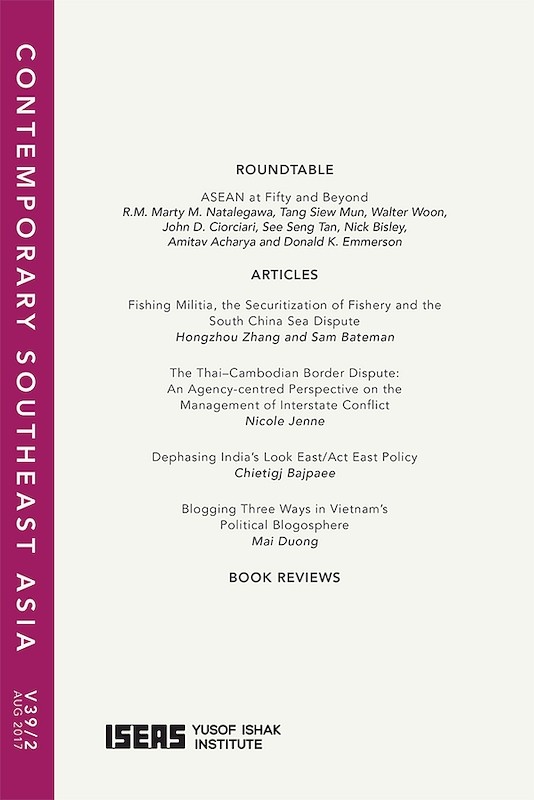
Ian Storey, editor
Date of publication:
August 2017
Publisher:
ISEAS – Yusof Ishak Institute
Number of pages:
188
Code:
CS39/2
About the publication
- Attained impact factor of 0.906 in Social Sciences Citation Index 2017
- Ranked 18th by Google Scholar Metrics 2018 in the Asian Studies and History category
Contents
-
Contemporary Southeast Asia Vol. 39/2 (August 2017)
[Whole Publication, ISSN: 1793284X] -
Preliminary pages
- ROUNDTABLE
-
1. Roundtable: ASEAN at Fifty and Beyond, by Marty Natalegawa, Tang Siew Mun, Walter Woon Cheong Ming, John D Ciorciari, See Seng Tan, Nick Bisley, Amitav Acharya, Donald K Emmerson, authors
- ARTICLES
-
2. Fishing Militia, the Securitization of Fishery and the South China Sea Dispute, by Zhang Hongzhou, Sam Bateman, authors see abstractWith fishery incidents emerging as a major threat to peace and stability in the South China Sea, a better understanding of the underlying causes of these incidents becomes important. Mainstream media, and a substantial body of academic literature, attribute these fishing incidents, and the growing presence of Chinese fishermen in the South China Sea, to China's strategic and political motives, claiming that these fishermen are actually fishing militia. Through revisiting the prevailing fishing militia narrative, this article argues that much wider economic and social factors are at work domestically in China, and that the international and regional scenes are more complex than the picture painted by purely viewing developments with China's fishing militia in isolation. This article also makes the case that fishing disputes in the South China Sea have been heavily securitized with profound implications for the ongoing territorial and jurisdictional disputes in those waters.
-
3. The Thai–Cambodian Border Dispute: An Agency-centred Perspective on the Management of Interstate Conflict, by Nicole Jenne, author see abstractArmed conflict between states in Southeast Asia has been relatively rare, especially since 1979. The most recent exception to this pattern was a border dispute between Cambodia and Thailand that turned violent in 2008 and remained militarized for more than three years. Existing studies of this long-standing conflict have concentrated on explaining the upsurge in violence between 2008 and 2011, but have tended to ignore that fighting was quickly contained each time clashes occurred. This article provides a different perspective and asks how the dispute was managed short of large-scale armed violence. To answer this question, the author adopts an agency-focused perspective that emphasizes the role of critical actors who worked to de-escalate the conflict. Based on field research conducted in Cambodia and Thailand, as well as consulting primary and secondary sources, the author adopts a historical narrative that revisits critical periods from the 1950s onwards and argues that relevant actors in both Cambodia and Thailand had long-standing incentives to avoid escalating the conflict. Two elements were critical: first, crucial actors including Cambodian and Thai bureaucrats, diplomats and members of the security and intelligence services developed an understanding of the problems inherent in defining their land border; and second, the establishment of personal contacts, even in the context of antagonistic relations. Together, these factors created possibilities for Cambodia and Thailand to cooperate in managing conflict and increased the willingness of both sides to exercise self-restraint.
-
4. Dephasing India's Look East/Act East Policy, by Chietigj Bajpaee, author see abstractIndia's Look East policy was launched in the early 1990s as part of a concerted effort to elevate the strategic importance of Southeast Asia in the country's foreign policy agenda. The policy has been described as going through various phases, with an accelerated pace and process of interaction in moving from one phase to the next, marked by a broadening and deepening of India's interaction with the region. This has culminated in the most recent phase under the government of Prime Minister Narendra Modi, which has rebranded the policy as Act East to signify a more pro-active and action-oriented approach towards the region. However, has there been any real and substantive change in India's engagement with Southeast Asia in moving from one phase to the next? Does this narrative of phases in India's post-Cold War engagement with Southeast Asia hold any substance? This article deconstructs the narrative of phases in India's Look East and now Act East policy and argues that India's eastward engagement has not been a process of simple linear progression. As such, while the concept of phases in India's Look East policy serves as a useful narrative device, it does not capture the nuances of India's post-Cold War re-engagement with Southeast Asia, which has been far more complex than this narrative suggests.
-
5. Blogging Three Ways in Vietnam's Political Blogosphere, by Mai Duong, author see abstractThis article discusses the dynamism of Vietnam's social media landscape by identifying three kinds of blogging and the different political views espoused by Vietnamese bloggers. This classification is based on a thematic analysis of blog postings, media discussions and semi-structured interviews conducted in 2013–15. The authors mapping of Vietnam's blogosphere demonstrates four features: first, the growth of political blogs; second, how the blogosphere has become an arena for competing political ideologies; third, the utilization of blogs by various factions within the Communist Party of Vietnam (CPV) to serve their own interests; and fourth, blogs as an important source of independent news and information. Understanding political blogs in Vietnam today helps us understand how Vietnamese bloggers maximize online freedom of speech, the zigzagging attitude of the CPV in managing the Internet in an attempt to reinforce its legitimacy and the challenges blogs pose to the state-run media's monopoly in the digital age.
- BOOK REVIEWS
-
BOOK REVIEW: Caretaking Democratization: The Military and Political Change in Myanmar. By Renaud Egreteau, by Jürgen Haacke, author
-
BOOK REVIEW: Man or Monster? The Trial of a Khmer Rouge Torturer. By Alexander Laban Hinton, by Andrew Mertha, author
-
BOOK REVIEW: Witch-Hunt and Conspiracy: The Ninja Case in East Java. By Nicholas Herriman, by Sana Jaffrey, author
-
BOOK REVIEW: Routledge Handbook of the Environment in Southeast Asia. Edited by Philip Hirsch, by Lee Poh Onn, author
-
BOOK REVIEW: A Great Place to Have a War: America in Laos and the Birth of the Military CIA. By Joshua Kurlantzick, by Kenton Clymer, author
-
BOOK REVIEW: The South China Sea Disputes: Past, Present, and Future. By Nalanda Roy, by James R. Holmes, author
-
BOOK REVIEW: Piracy in Southeast Asia: Trends, Hot Spots and Responses. Edited by Carolin Liss and Ted Biggs, by Chris Rahman, author

